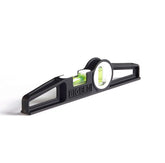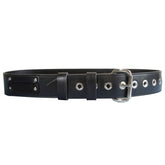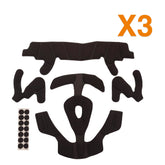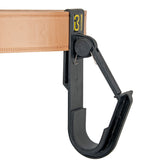Regulations, specifically the Work at Height Regulations 2005, are critical as we continue on our journey of improving the health and safety of workers on site.
In the scaffolding industry, we know a great amount of work is undertaken at height. Unfortunately, it’s also true that a large percentage of injuries on-site are attributed to working at height in some way.
Deploying the right height safety measures is therefore critical.
Regulations have given us the frameworks and guidance we need to deploy measures that improve site safety and instil a greater safety culture around working at height.
But the complexities of regulations can sometimes generate confusion. As a specialist supplier of height safety equipment, many members of the team at Leach’s are asked about the Working at Height Regulations 2005 and what the implications of the rules are for safety managers, safety executives and business owners.
Never one to disappoint, we’ve collated the top 10 questions we’re asked to help you demystify some of the finer details of the regulations and equip you with the knowledge you need to confidently stay informed, legal and safe.
-
#1 – Why do we have working at height regulations?
The purpose of working at height regulations is to minimise the risk of injury when working at height.
This isn’t about stopping work at height taking place. We all know this is necessary to do the work that needs doing. Instead, the regulations focus on ensuring all the practical steps are taken to enable those working at height to carry out their roles safely.
-
#2 – What is the regulation’s definition of working at height?
According to the Health and Safety Executive (HSE), work at height refers to:
“Work in any place, including a place at or below ground level, or obtaining access to or egress from such a place, while at work, except by a staircase, where, if suitable measures were not taken, a person could fall a distance likely to cause personal injury.”
So, working at height refers to any work conducted whereby a fall from distance could result in injury. This risk of injury is the primary reason for the implementation of proper safety precautions. Typical examples of work at height include:
- Working on a ladder
- Working on a flat roof
- Working on fragile surfaces
- Working near a hole in the ground or an opening in the floor
There is of course always a risk element attached to working at height. Perhaps accidents are even inevitable from time to time. However, this regulation is vital for that safety culture to continue spreading industry wide.
-
#3 – Can I be fined for not adhering to the Working at Height Regulations 2005?
Yes, you can be fined for lack of adherence with the Working at Height Regulations. Not to scaremonger, but you can also be imprisoned depending on the severity of the offence. There are many examples where employees and senior executives have been held responsible, taken to court, fined and sometimes imprisoned.
But fines and imprisonments are just the deterrents. What we really want to focus on is protecting our workers on-site, and helping those who are undertaking the work do so in the safest manner possible.
-
#4 – Who is responsible for implementing the Work at Height Regulations?
It is the responsibility of the employer, or the person or employee who controls work at height, to make sure the working at height regulations are upheld. The regulations also state that this must be a competent person.
-
#5 – What is meant by a competent person?
Competency is often assured though appropriate training and experience. It is good practice for both the trainer and the trainee to note and sign off all training so competency can be proven when needed.
-
#6 – What are the practical steps to take to make sure we are working within the Working at Height Regulations 2005?
There are many steps that should be taken to ensure adherence with the Working at Height Regulations, including (but not limited to):
- Employers and those in control of working at height must make sure all work is properly planned, supervised and carried out by competent persons.
- If you need to work at height. All work should be done with two feet on the ground if possible and suitable.
- Risks must be assessed and if there is no alternative but to work at height, you must put in place the appropriate measure to minimise the risks.
- If it is not feasible to eliminate the risk by using a collective system, then a personal protective equipment (PPE) system must be used, be it for restraint or fall arrest purposes.
- Be aware of your working environment at all times, as it can change quickly.
- Use the right equipment for the task in hand.
- Make sure the equipment is regularly maintained and checked.
- Have an emergency rescue and evacuation plan that is understood by all.
-
#7 – When planning work at height, what questions should I be asking?
Within a thorough risk assessment, it’s important you ask certain questions before work at height commences. This will help identify the risks and enable you to deploy the appropriate preventative measures. Questions include:
- Is the general work environment safe? For example, how structurally sound is the roof?
- Are there likely to be any adverse weather conditions on site?
- How can I stop objects from falling? For example, tool tethering.
- Does the nature of the work mean objects might fall no matter what measures I might take?
- How can I reduce this risk? For example, debris netting.
- What materials and objects are on site and can they be stored safely?
- What should I do if we have an emergency or rescue situation?
- How do we inform workers of the emergency and rescue plan?
-
What training do workers need to put this plan into action?
-
#8 - What equipment considerations should I have when working at height?
It’s imperative that any equipment you’re using is appropriate for the task and is used and installed correctly. If in doubt, ask an informed third party.
It’s also important to regularly inspect all PPE and equipment and ensure any failed items are discarded, rectified, or repaired. Keep records of all inspections so you’re confident your equipment is safe to use.
-
#9 – What work elements are particularly noted as increasing risks for working at height?
There are certain workplace elements that will increase the risks associated with working at height, and as such, special attention should be paid in these conditions.
For example, while ladders and step ladders can be used for working at height, they should only be considered if there is no justifiable reason to use another piece of equipment. The risk of using a ladder or step ladder should be assessed prior to their use. If a ladder or step ladder is likely to be used for a long period of time, an alternative may be more suitable.
Furthermore, guard rails on working platforms must meet the specifications set out by the HSE. Mobile elevated work platforms or mobile scaffolding should be carefully assessed by a competent person before being used.
It is also a requirement of the Working at Height Regulations that unless a scaffold is assembled to a generally recognised standard configuration, e.g. NASC Technical guidance TG20 for tube and fitting scaffolds, the scaffold should be designed by bespoke calculation and by a competent person to ensure it will have adequate strength, rigidity and stability while it is erected, used and dismantled.
-
#10 - Is there any specific advice on erecting scaffolding?
Yes there is specific advice on erecting scaffolding.
All scaffolding must be erected, dismantled, and altered in a safe manner. This is achieved by following the guidance provided by the NASC in document SG4 ‘Preventing Falls in Scaffolding’ for tube and fitting scaffolds, or by following similar guidance provided by the manufacturers of system scaffolding. A full check-list can be found here.
Need some more support?
We’ve put together this guide of the Working at Height Regulations 2005 to cover the main points of the regulation and get you thinking about your own organisation and how best to implement the regulations. Of course, this isn’t an exhaustive guide and we always recommend speaking to a height safety specialist to support your requirements. We’ve also included some helpful links below to give more depth on the regulations.
If you require any equipment advice, or if you have any further questions, please contact our dedicated sales team on sales@www.leachs.com or 01432 246 800.
Further resources:


















